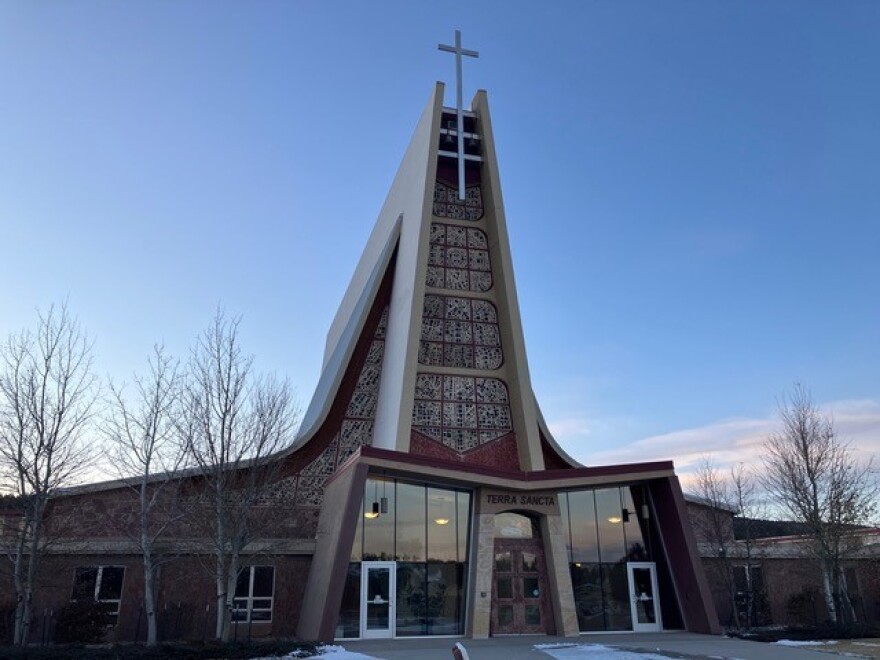My writing has always mattered to me, a lot.
It’s one of the few things in life that I think I do pretty well.
Don’t ask me to explain particle physics, build a wooden cabinet, paint an elegant watercolor scene or fix an ailing carburetor (do cars still have them?).
Stuff like that I can’t do. Won’t even try.
But give me a pen and paper or a keyboard and a computer screen and I can probably arrange a cluster of thoughts into words that mean a thing or two. To some people, at least, including me.
For 50 years, writing has been my love and my profession. Sometimes it has also been my psychological therapy. Sometimes essential therapy. And all of that matters, so much.
But it was only about 10 years ago that I realized that my writing was something even more than all of that. And that essential epiphany didn’t just happen. Sister Jane Frances Mullaney made it happen.
My writing, she pointed out, was also my ministry. My ministry. Think about that.
I’ve been thinking about that a lot since Sister Jane Frances died last Thursday. And sad as I am about her passing, I really can’t bring myself to say she died too soon. She was 102, and two months short of 103.
She had an extraordinarily full life. And she was ready — oh, so ready — to meet her maker.
My cousin Mike, who is more commonly known hereabouts as Monsignor Michael Woster, was fortunate — he said so himself — to be there to administer Last Rites to Sister Jane Frances. It wasn’t their first sacramental meeting. Monsignor Mike had offered Jane Frances the Eucharist two or three times a week in the months leading up to her death.
Since he retired as a full-time priest and pastor in July, my cousin has been offering the sacraments to the Benedictine sisters at St. Martin Monastery, a service he provides with pleasure and gratitude. He said during his homily at Sister Jane Frances’ funeral mass that she always thanked him sincerely after mass.
“She said ‘Thank you,’” he said. “But I could see in her eyes that she was also saying ‘Bless you.’ “
And Monsignor Mike said he felt blessed, indeed.
I felt blessed that my cousin was the presiding celebrant along with other priests for the Sister Jane Frances’ funeral mass in the beautiful stone-and-wood Holy Cross Chapel.
The chapel was once part of the larger monastery complex that was converted into the Terra Sancta Retreat Center, a Catholic elementary school and other offices.

Together in life. Together in Death
A smaller monastery with a chapel, guest wing and health-care wing was built nearby. It’s a beautiful little complex, where Sister Jane Frances spent the last years of her life.
The monastery cemetery, where the headstones marking the graves of sisters are lined in neat rows, is in a grassy opening between the old and the new buildings. And there Monsignor Mike and Father Dan Juelfs offered the final prayers over Sister Jane Frances’ mortal remains, before her dignified-but-plain, biodegradable casket — reflecting the simplicity of the Benedictine way — was lowered into the earth.
Ashes to ashes, dust to dust, the funeral prayer proclaims.
Together with her sisters in life. Together in death. Exactly how Sister Jane Frances wanted it.
Born the third of six children to Frank and Helena Mullaney on a farm near Sioux Falls on Feb. 5, 1920, Kathleen Marie Mullaney moved to Sturgis with her family in 1927. At 14, she entered the St. Martin Convent as an aspirant, which is someone who moves into a community of women religious to begin a process of discernment about whether that life fits for them and they fit for the community.
She made her profession as a Benedictine sister in 1938. Part of that process, especially in those days prior to changes brought by Vatican II in the early 1960s, was for sisters to take on a new name reflecting their new relationship with God.
Sister Jane Frances attended St. Martin Academy and Mount Marty College and became a registered nurse through St. John’s Hospital in Rapid City, where she also was certified as an x-ray technician.
She continued in medicine with a degree from Mercy College in Detroit and specialties in laboratory and blood bank work, later working as clinical instructor in pediatrics at St. John’s, administrator/director of nursing at the hospital in Martin and then in a supervisory role at the health-care unit back at St. Martin Monastery.
The sisters go where they are needed when they are needed.
While she was at St. John’s in June of 1972, the Rapid City Flood devastated the community. In the early hours of the flood, top officials at the hospital were out of town for a banquet and Sister Jane Frances was the only one left in the hospital who knew the emergency response plan. She led work to prepare for the influx of flood victims and worked the rest of day, through the night and through the next day.
When someone asked Sister Jane Frances how long she had been working without sleep, she said: “I don’t know. What day is it?”
For her, every day was one full of prayer, contemplation and service.
In her later years, Sister Jane Frances worked as hospitality coordinator at the monastery. And as many noted, she was a model of hospitality.
She is not alone in that. It is the Benedictine way. And I have been lucky — and am lucky — to experience that at St. Martin.

Getting to know the sisters
The Benedictine Sisters of St. Martin are a small, declining community of women religious giving witness to the presence of God in community life through prayer, work, study and leisure “lived purposely.” They offer a welcoming spirit and hospitality that includes workshops, retreats and spiritual guidance.
They make a difference every day in the church, in their community and in the individual lives of those of lucky enough to know them.
I got involved with St. Martin Monastery more than 20 years ago through my wife, Mary. She was for many years a religion writer for the Rapid City Journal who covered the monastery and its sisters. Eventually, Mary joined the monastery’s oblate group.
Oblates — from a Latin word meaning offered or dedicated — are men and women, Catholics and non-Catholics, ordained or lay, who affiliate with a monastery and commit to living the Benedictine way and taking the spirit of Saint Benedict and the Benedictines into their daily lives.
I first went to St. Martin Monastery in 2001 when I started to travel from Sioux Falls to Rapid City on weekends to see Mary, not long before we got engaged. We often joined Sister Marmion Howe and others on Saturday mornings for centering prayer, a meditative-type prayer done individually but in a group setting.
The centering prayer was usually followed by cookies and coffee/tea, conversation and a video on contemplative prayer and related subjects. And sometimes Mary and I would stay for lunch with the sisters and the oblates.
Through that process, Mary got closer to the St. Martin community, and I was fortunate to tag along.
I knew Sister Marmion first and best. But one by one, I got to know and like and learn from other sisters at the monastery, including Sister Jane Frances.
By then Mary and I were married and I had left my job with the Argus Leader in Sioux Falls and returned to the Rapid City Journal, joining Mary in the newsroom. Several of the sisters regularly complimented both Mary and me on our columns, and were enthusiastic readers.
During one of our visits to St. Martin, I was talking to Sister Jane Frances about various service ministries that oblates and others had. I was then in-between my lay ministry as an altar server and lector for daily mass at Our Lady of Perpetual Help Cathedral and similar daily mass ministry I later commenced at St. Isaac Jogues Catholic Church in North Rapid.
Writing as a ministry? Well, of course
So I didn’t have a ministry, I thought. And I was lamenting that fact when Sister Jane Frances smiled, put her hand on my arm and said: “Dear, your writing is your ministry. Don’t you know that?”
Well, once she mentioned it, no, I hadn’t known that. Then, suddenly, I did, thanks to Sister Jane Frances.
My writing had always mattered to me. But thinking of it in terms of a ministry made it matter even more. And it added to the sense of responsibility I already felt to shape my writing toward some essential truth.
When I mentioned the ministry point to other sisters at the monastery, they nodded knowingly, as if to say: “Well, of course.”
Some of those same sisters will read this column. At least one planned to listen in when I discussed Sister Jane Frances on In the Moment with Lori Walsh.
Others, of course, have passed on and will have to read or listen in ways we can’t yet understand.
The last time I saw Sister Marmion was in February of 2020. We gathered for Sister Jane Frances’ 100th birthday party. Sister Marmion was there, too, but noticeably weaker than the last time I had seen her.
Even so, when I bent close to Sister Marmion with a greeting she brightened and said: “Oh, it’s so good to see you.”
And so good it was to see her.
Sister Marmion’s 100th birthday party was coming on March 29, 2020. But Mary and I wouldn’t get back for that. COVID-19 hit and access to St. Martin and its vulnerable population of elderly nuns was tightly restricted.
Sister Marmion died on that following Thanksgiving Day. I wrote about her on this blog a few days later.
That birthday party for Sister Jane Frances was the last time I would see her, too. Mary and other oblates started returning to St. Martin after COVID vaccines and treatments came in. But I hadn’t been there since that party.
COVID was followed for me by a combination of medical issues that limited my activities for the better part of a year. But there were times in recent months when I could have made it out to the monastery with Mary, and I didn’t. I had other things going on. Things that seemed more important than they were.
I’ll always regret that.
After one of Mary’s recent visits for an oblate gathering, she said she feared Sister Jane Frances was failing, since family members were there more often.
Then, last Friday, I was doing dishes in the kitchen and Mary was sitting at the dining-room table going through emails on her phone when one stopped her: “Oh. Sister Jane Frances died.”
My hearing isn’t great. And the dishes were clattering. “Who did what?” I said.
“Sister Jane Frances. She died,” Mary said. “Remember how much she loved your writing?”
I stood still with a dish in my hands. Of course, I remembered.
Mary’s eyes were teary, but she was smiling. “She was 102. What a wonderful life.”
Indeed, what a wonderful life, and one that deeply touched so very many, including a guy who came later in his own life to the powerful understanding that, yes, his writing was his ministry.


